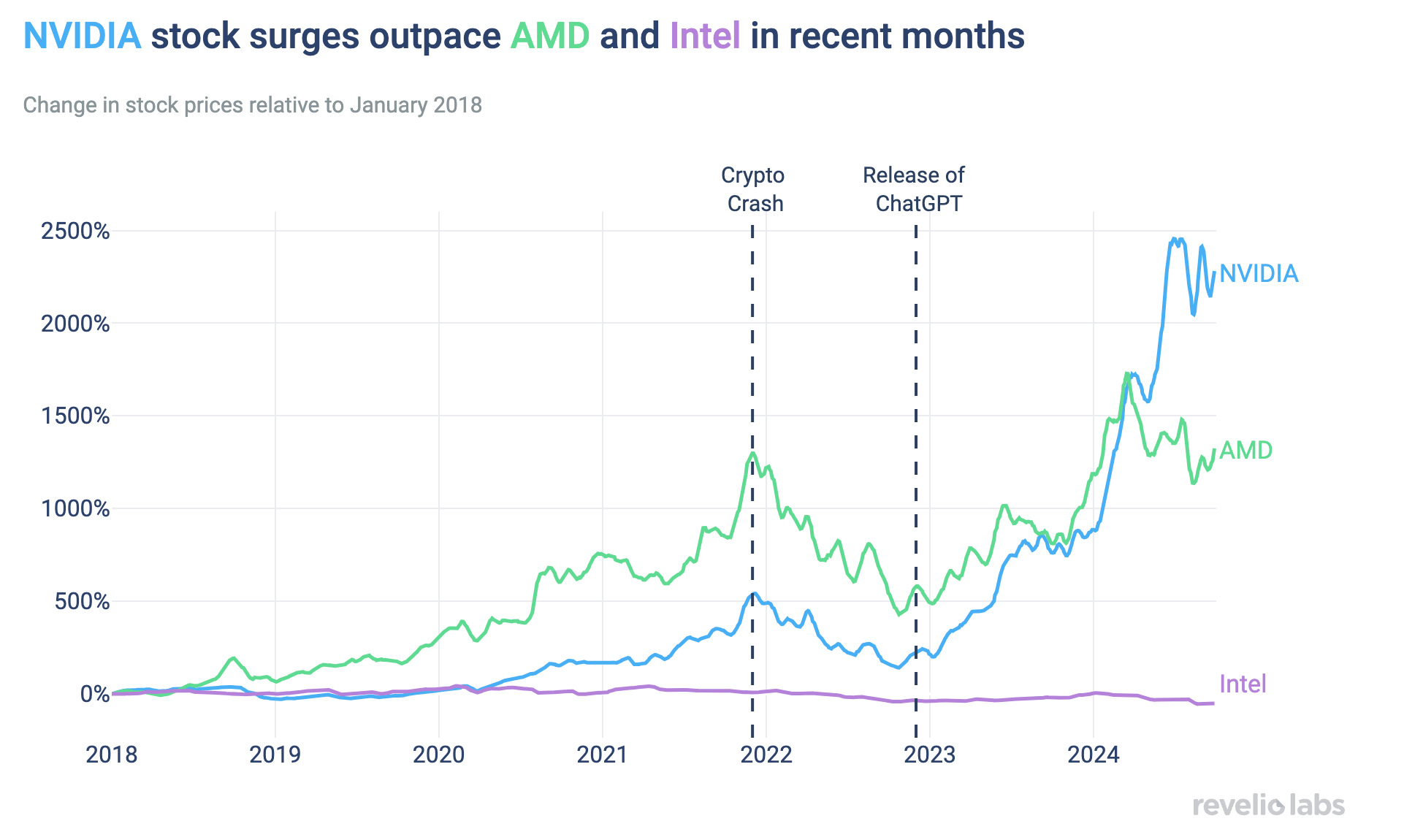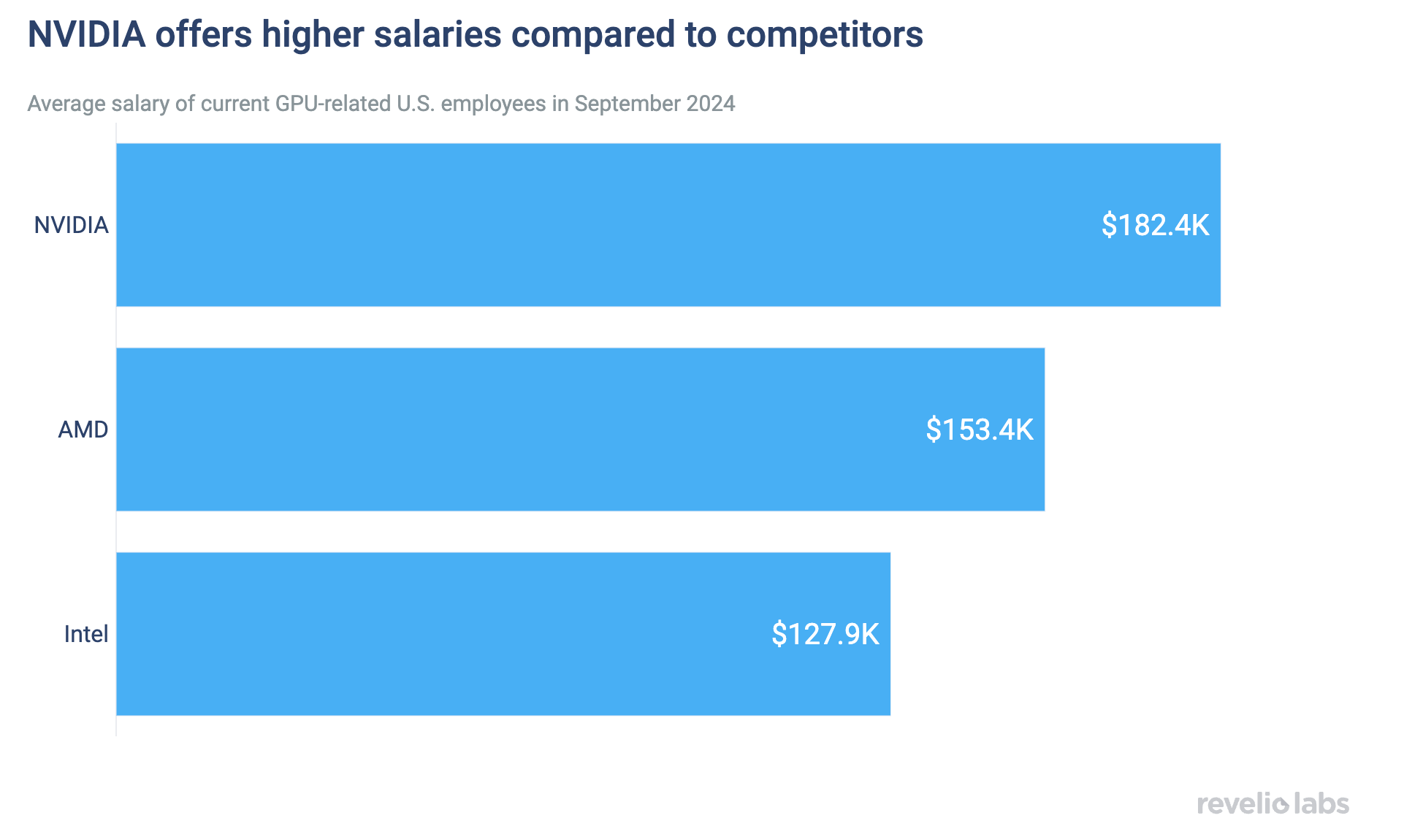The Workforce Strategy Behind Nvidia’s Meteoric Rise to Dominance
NVIDIA is riding high on AI because of its early investment in GPU talent

NVIDIA's early and substantial investment in building a robust GPU workforce has been a key driver of its market dominance, a strategy reflected in the company’s stock performance during pivotal moments of GPU adoption.
NVIDIA’s extensive developer ecosystem, built around its popular CUDA technology, has increased its market share and helped attract a steady stream of skilled workers.
By attracting top talent from competitors and offering competitive salaries, NVIDIA continues to maintain its edge in the rapidly evolving GPU and AI markets.
NVIDIA, a company that started as a manufacturer of graphics processing units (GPUs) primarily used for gaming, has grown into a pivotal player in the tech industry. GPUs, originally designed to handle complex graphics, have become essential for a wide range of computing tasks, including powering the AI systems behind technologies like large language models (such as ChatGPT) and cryptocurrency mining. As these technologies have become more central to our digital lives, NVIDIA’s GPUs have been in high demand, leading to significant increases in the company’s stock price and solidifying its position as a leader in the industry.
NVIDIA’s approach to workforce development, including its strategic hiring and ecosystem-building, provides a roadmap for other companies looking to maintain or grow their influence in emerging tech sectors. Understanding these labor dynamics sheds light on the broader “talent wars” in tech, raising questions about how competitors will adapt to retain critical talent in the fast-evolving world of AI and GPUs.
The impact of NVIDIA's strategic workforce investment is clearly reflected in the company's stock price over the years, particularly during pivotal moments in GPU adoption. One significant example is the peak of the cryptocurrency boom in November 2022, when NVIDIA's stock saw a substantial rise due to the high demand for GPUs used in crypto mining. However, as the cryptocurrency market began to decline, so did NVIDIA’s stock, reflecting the industry's volatility. Similarly, the release of ChatGPT in November 2023 marked another turning point for NVIDIA, reigniting its stock price. This correlation between market trends, workforce growth, and stock performance highlights how NVIDIA’s human capital strategy has been integral to its success.


Sign up for our newsletter
Our weekly data driven newsletter provides in-depth analysis of workforce trends and news, delivered straight to your inbox!
NVIDIA’s developer ecosystem, which includes professionals skilled in technologies like CUDA, has grown substantially larger than those of its competitors, Intel and AMD. The developer ecosystem refers to the community of professionals—developers, engineers, and researchers—outside of their respective firms who are engaged with these technologies. Revelio Labs workforce data shows that NVIDIA’s ecosystem is particularly robust due to the widespread adoption of CUDA. By fostering a larger and more active developer community outside the firm, NVIDIA not only ensures a steady supply of skilled talent but also strengthens its market share and creates powerful network effects. This ecosystem fuels NVIDIA's continued success and enables the company to push the boundaries of what its GPUs can achieve.


NVIDIA’s rise to dominance in the GPU industry can be traced back to its early and substantial investment in building a robust GPU-focused workforce. As demand for advanced graphics processing surged, particularly with the advent of AI and deep learning technologies, NVIDIA positioned itself at the forefront by aggressively expanding its talent pool. The total wage bill for GPU-related positions has consistently outpaced that of its competitors since the beginning. This early commitment to workforce development allowed NVIDIA to innovate rapidly, setting the stage for its current leadership in the industry.


Not only is the total wage bill significantly higher, but NVIDIA’s commitment to attracting and retaining top talent is also evident in its competitive salary offerings. The company consistently pays above the industry average, particularly for roles critical to its GPU and AI initiatives. This helps NVIDIA attract the best talent from across the industry and ensures that its employees are motivated and satisfied, driving continued innovation and maintaining the company’s position as a leader in the rapidly evolving tech landscape.


NVIDIA’s hiring strategy has been closely aligned with its growing market share in the GPU sector, as evidenced by the correlation between job postings and stock performance. As the company’s GPU market share improved, NVIDIA responded by ramping up its hiring efforts. Surges in job postings often follow peaks in NVIDIA’s stock price, reflecting the company’s commitment to scaling its workforce in response to market opportunities, which has enabled NVIDIA to maintain its competitive edge. In its pursuit of maintaining a competitive edge, NVIDIA has bolstered its innovation pipeline while simultaneously weakening its competitors'. Notably, over the past year, NVIDIA saw the most significant inflow of talent from Intel, with 231 employees joining, accounting for 9.24% of all its new hires.


In understanding NVIDIA's rise to dominance, we gain valuable insights into the broader significance of workforce intelligence data and the company’s role in the tech landscape. NVIDIA’s story exemplifies how strategic workforce investments can translate into technological innovation, market leadership, and financial success. NVIDIA is particularly interesting because it sits at the intersection of several key technological trends— AI, machine learning, and parallel computing—that are reshaping our world.
By examining how NVIDIA has cultivated its workforce and developer ecosystem, we can better understand the mechanisms through which companies drive and sustain innovation. This, in turn, highlights the importance of labor market data not just for tracking current trends, but for anticipating future industry shifts and identifying the companies that are likely to lead the way.


